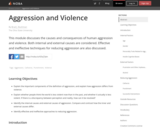
By the end of this section, you will be able to:Define aggressionDefine cyberbullyingDescribe the bystander effect
- Subject:
- Psychology
- Social Science
- Material Type:
- Module
- Author:
- Cheryl Williams-Jackson
- Date Added:
- 11/09/2019

By the end of this section, you will be able to:Define aggressionDefine cyberbullyingDescribe the bystander effect

This module discusses the causes and consequences of human aggression and violence. Both internal and external causes are considered. Effective and ineffective techniques for reducing aggression are also discussed.

In our final episode of Crash Course Psychology, Hank discusses the ideas of Aggression and Altruism. These two things are difficult to understand and explain so sit tight and get ready to run the gauntlet of human emotions.
Chapters:
Introduction: Robber's Cave Experiment
Conflict vs. Cooperation
Aggression
Genetic, Neurological, & Biochemical Reasons for Aggression
Frustration-Aggression Hypothesis
Altruism
Bystander Effect
Why do we help others?
Social Exchange Theory & the Norm of Reciprocity
Social Responsibility Norm
Conflict & Self-Interest
Review & Credits
Credits

Stanford University professor Robert Sapolsky presents the course Human Behavioral Biology. He begins by explaining the premise of the course and how he aims to avoid categorical thinking. (March 29, 2010)
Human behavioral biology examines traits such as human sexual behavior, emotions memory, perception, and language from a biological perspective. It seeks to identify how human behavior is influenced by brain, sensory, hormone, fetal development and other biological influences.

Psychology is designed to meet scope and sequence requirements for the single-semester introduction to psychology course. The book offers a comprehensive treatment of core concepts, grounded in both classic studies and current and emerging research. The text also includes coverage of the DSM-5 in examinations of psychological disorders. Psychology incorporates discussions that reflect the diversity within the discipline, as well as the diversity of cultures and communities across the globe.Senior Contributing AuthorsRose M. Spielman, Formerly of Quinnipiac UniversityContributing AuthorsKathryn Dumper, Bainbridge State CollegeWilliam Jenkins, Mercer UniversityArlene Lacombe, Saint Joseph's UniversityMarilyn Lovett, Livingstone CollegeMarion Perlmutter, University of Michigan


By the end of this section, you will be able to:Define aggressionDefine cyberbullyingDescribe the bystander effect


Provides standard introduction to psychology course content with a specific emphasis on social aspects of psychology. This includes expanded content related to social cognition, aggression, attraction and similar topics.

This course examines interpersonal and group dynamics, considers how the thoughts, feelings, and actions of individuals are influenced by (and influence) the beliefs, values, and practices of large and small groups. Learning occurs through a combination of lectures, demonstrations and in-class activities complemented by participation in small study groups and completion of homework assignments.